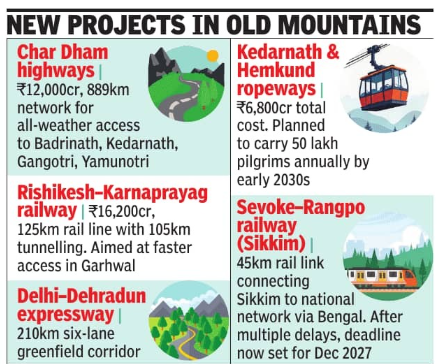ARTICLE AD BOX

KULLU/DEHRADUN: This monsoon, from Kullu to Kalimpong, Kishtwar to Karnaprayag, landslides, flash floods and ground subsidence sharpened the focus on how India's expanding network of highways, tunnels, ropeways and hydropower dams is affecting the fragile Himalayan terrain.
While officials insist these were natural calamities, a growing number of residents, scientists and campaigners point to unscientific construction as a key driver.In many towns and villages in India's hills, protests have intensified over cracked homes, vanished springs and roads that collapsed as quickly as they were built.Top Court Seeks AnswersEarlier this week, Supreme Court said the entire Himalayan range was facing an ecological crisis.
And that conditions were "very violent" this year. Talking about its suo motu examination of environmental issues facing not just Himachal but also Uttarakhand and other states, the top court wondered if there was a link between the spate of rain-related events and the fast-paced construction of roads, hydro schemes, buildings and other big infrastructure projects currently on.
Visible scars appeared recently on the 197km Chandigarh-Manali highway, where large sections slumped after cutting by National Highways Authority of India left near-vertical slopes of sand and gravel vulnerable to heavy rain.
Carriageways were buried, tunnels flooded, and the Beas was choked with debris.

Drive Slow, Danger Ahead"There used to be hardly any landslides," said Kullu environmentalist Guman Singh. "Then came NHAI with its vertical cuts and created a mess of a road." Former Geological Survey of India director Om Narain Bhargava called the technique "a horrible mistake". Villagers demanded relocation and compensation after their homes developed cracks. Activist Madan Sharma called it "the most dangerous road ever built," while state rural development minister Anirudh Singh launched a 'Justice for Himachal' campaign, saying the highway had created "more problems than it solved." A state climate report had already warned that such cutting would "exacerbate land instability." Sharp disagreements over the cause of recent calamities have surfaced in Uttarakhand next door.
Chief secretary Anand Bardhan told TOI there was "no technical or scientific study" linking large infrastructure to natural disasters, citing the flash flood in Dharali, which killed several, as an example of a disaster in a zone without major projects. He added that ropeways to Kedarnath and Hemkund Sahib had not yet begun and cautioned against speculation.Campaigners, however, said the impacts were widespread. "All ecological and local factors have been sidelined," said Brijesh Sati of the Char Dham Teerth Purohit Mahapanchayat.
"It would not be wrong to say these disasters are man-made. We are not against development, but it must respect ecology." He said 50,000 pilgrims completed the Char Dham yatra in 1905 without roads and that even in 2000, road broadening was done without felling trees.Expert opinion from the Supreme Court's high-powered committee on the Char Dham project underscored the risks. Environmentalist Ravi Chopra, who chaired the committee, explained that Uttarakhand's Himalayan ranges emerged from three major faults.
"Even though the rock may be strong, the slopes are weak. During field visits we saw them weakened further by deforestation and unscientific road-cutting - slopes of 60 degrees were carved where even 30 degrees is unsafe.
" He added that climate change had increased the frequency of disasters.Not God But Man?Evidence of man-made pressures came from across the scientific community. S K Bartarya, former senior hydrogeologist at the Wadia Institute of Himalayan Geology, said both human activity and climate change were to blame.
"Drying of water bodies are surfacing across the Himalayas. To understand the impact of projects we need cause-factor analysis to separate man-made pressures from climatic ones."Lived memory offers its own testimony. Uttarkashi-based campaigner Suresh Bhai said, "Floods from Kedarnath in 2013 to Joshimath in 2023 show the health of the Himalayas is being spoiled. Development at the cost of ecology requires reassessment."IPCC author Anjal Prakash called big projects in the mountains "disaster multipliers" that destabilise slopes. Shruti Narayan of C40 said infrastructure in fragile zones must be based on scientific evidence "or risk becoming victims of the very calamities they claim to overcome."Anxiety & AngerAnxiety has become part of daily life in Sikkim, where a glacial lake outburst flood in Oct 2023 destroyed the Rs 1,200 crore Teesta III dam within minutes, swept away more than a dozen bridges on NH-10, and killed over 90 people.
A July 2025 report said many families now kept their bags packed at night, unsure of early warning systems. The Sevoke-Rangpo railway tunnel continued beneath slopes some locals said were still settling.
In Pakyong and Namchi, natural springs used for drinking and irrigation had begun drying. A travel magazine recorded complaints that newly widened roads lacked drainage. "We are not engineers," a villager said, "but we live here.
We know when the mountain is being hurt."In Himachal's Lahaul & Spiti, hundreds marched in May against the proposed Seli and Miyar schemes, alleging that avalanche risks had been ignored and impact assessments withheld.With landslides increasing, extreme rain events rising and traditional water sources vanishing, the future of infrastructure in the Himalayas now hinges on whether engineers and planners can align ambition with the limits of the land.



.png)
.png)
.png)
















 1 hour ago
4
1 hour ago
4









 English (US) ·
English (US) ·